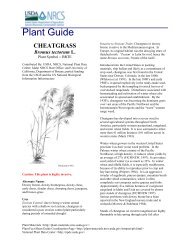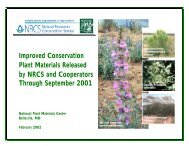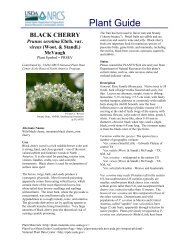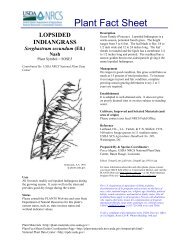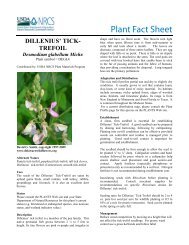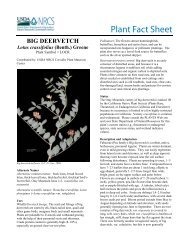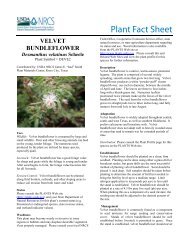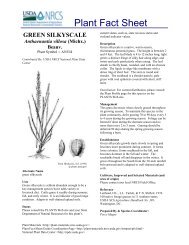slender little bluestem - USDA PLANTS Database - US Department ...
slender little bluestem - USDA PLANTS Database - US Department ...
slender little bluestem - USDA PLANTS Database - US Department ...
Create successful ePaper yourself
Turn your PDF publications into a flip-book with our unique Google optimized e-Paper software.
SLENDER LITTLE<br />
BLUESTEM<br />
Schizachyrium tenerum Nees<br />
Plant Symbol = SCTE5<br />
Contributed By: <strong><strong>US</strong>DA</strong> NRCS National Plant Data<br />
Center<br />
Alternate Names<br />
<strong>slender</strong> <strong>bluestem</strong>, Andropogon tener<br />
Plant Fact Sheet<br />
From Hitchcock (1950)<br />
@ plants.usda.gov<br />
Uses<br />
Although <strong>slender</strong> <strong>little</strong> <strong>bluestem</strong> is not one of the<br />
preferred forage grasses in the southern U.S., cattle<br />
graze it when it is young and tender.<br />
Status<br />
Please consult the <strong>PLANTS</strong> Web site and your State<br />
<strong>Department</strong> of Natural Resources for this plant’s<br />
current status, such as, state noxious status, and<br />
wetland indicator values.<br />
Description<br />
Grass Family (Poaceae). Slender <strong>little</strong> <strong>bluestem</strong> is a<br />
native, warm-season, perennial bunch grass. The<br />
height is between 1 and 3 feet, often found reclining<br />
or lying flat on ground. The leaf blade is narrow; 2 to<br />
8 inches long; 1/16 inch wide or less; wiry. The leaf<br />
sheath is rounded; smooth; mostly basal. The ligule<br />
is hairy. The stem is a bend at each node giving a<br />
zigzag appearance; often branching at nodes. The<br />
seedhead is single straight spike-like raceme on each<br />
seed stalk. The seeds shatter soon after maturity,<br />
leaving a tiny hollow tip on each stalk.<br />
Distribution: For current distribution, please consult<br />
the Plant Profile page for this species on the<br />
<strong>PLANTS</strong> Web site.<br />
Management<br />
Grazing practices should favor the broader leafed,<br />
more palatable grasses rather than <strong>slender</strong> <strong>bluestem</strong>.<br />
Heavy grazing for a short period after spring growth<br />
starts followed by a 6-month grazing deferment and<br />
light use make it possible for later maturing grasses,<br />
such as pinehill <strong>bluestem</strong> (Schizachyrium scoparium<br />
var. divergens) to shade out <strong>slender</strong> <strong>bluestem</strong> and<br />
dominate the site. Slender <strong>bluestem</strong> increases if<br />
burned annually and grazed continuously. New<br />
growth following a burn is the most palatable. As<br />
seed stalks form, palatability declines rapidly. It is an<br />
indicator of excessive grazing.<br />
Establishment<br />
Growth starts in the early spring and continues into<br />
the summer. The seedheads generally form by<br />
mid-July. In the fall and winter, foliage tangles, mats<br />
together, and turns a faded straw color. This species<br />
grows in colonies. Slender <strong>bluestem</strong> is not as shade<br />
tolerant as many associated grasses. It is best<br />
adapted to open or sparsely wooded poorly drained<br />
soils and is also found on sandy well-drained soils.<br />
Cultivars, Improved and Selected Materials (and<br />
area of origin)<br />
Please contact your local NRCS Field Office.<br />
Reference<br />
Leithead, H.L., L.L. Yarlett, & T.N. Shiflett. 1976.<br />
100 native forage grasses in 11 southern states.<br />
<strong><strong>US</strong>DA</strong> SCS Agriculture Handbook No. 389,<br />
Washington, DC.<br />
Plant Materials <br />
Plant Fact Sheet/Guide Coordination Page <br />
National Plant Data Center
Prepared By & Species Coordinator:<br />
Percy Magee, <strong><strong>US</strong>DA</strong> NRCS National Plant Data<br />
Center, Baton Rouge, Louisiana<br />
Edited: 13may02 ahv; jul03 ahv; 20sep05 jsp; 070116 jsp<br />
For more information about this and other plants, please contact<br />
your local NRCS field office or Conservation District, and visit the<br />
<strong>PLANTS</strong> Web site or the Plant Materials<br />
Program Web site <br />
The U.S. <strong>Department</strong> of Agriculture (<strong><strong>US</strong>DA</strong>) prohibits<br />
discrimination in all its programs and activities on the basis of<br />
race, color, national origin, sex, religion, age, disability, political<br />
beliefs, sexual orientation, and marital or family status. (Not all<br />
prohibited bases apply to all programs.) Persons with disabilities<br />
who require alternative means for communication of program<br />
information (Braille, large print, audiotape, etc.) should contact<br />
<strong><strong>US</strong>DA</strong>'s TARGET Center at 202-720-2600 (voice and TDD).<br />
To file a complaint of discrimination write <strong><strong>US</strong>DA</strong>, Director, Office<br />
of Civil Rights, Room 326-W, Whitten Building, 14th and<br />
Independence Avenue, SW, Washington, DC 20250-9410 or call<br />
202-720-5964 (voice or TDD). <strong><strong>US</strong>DA</strong> is an equal opportunity<br />
provider and employer.<br />
Read about Civil Rights at the Natural Resources Convervation<br />
Service.



